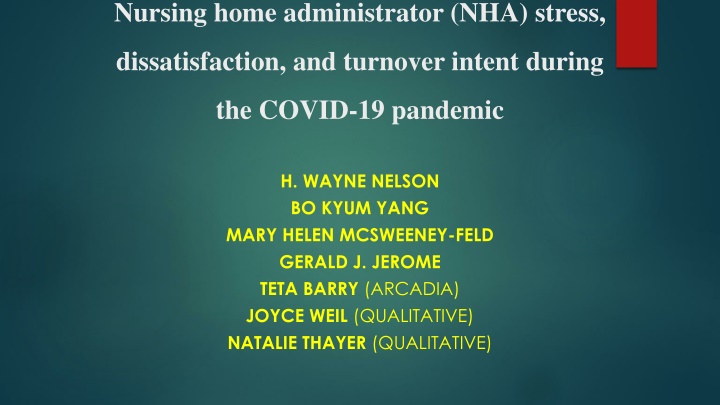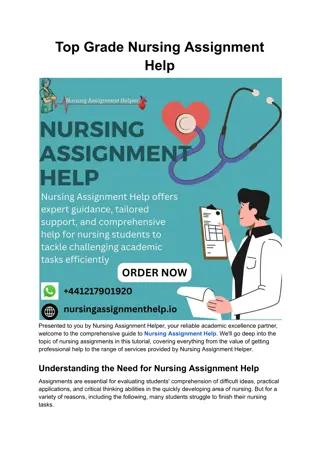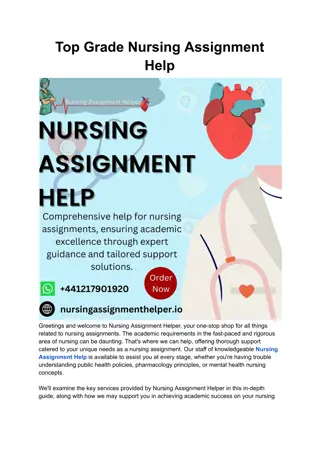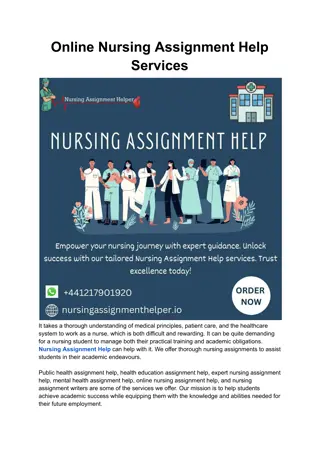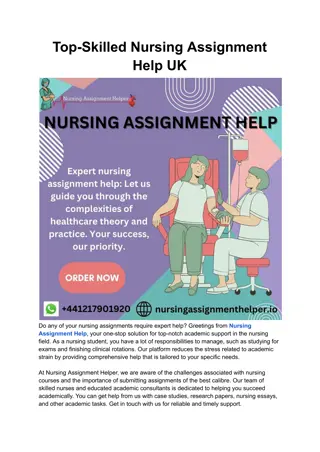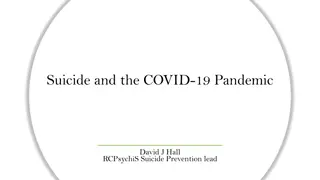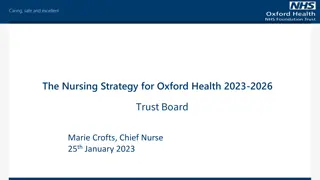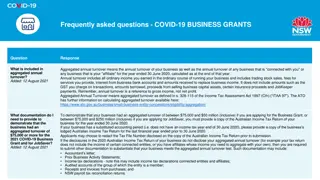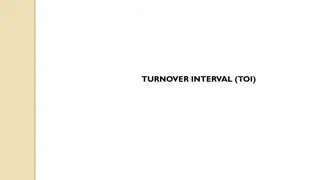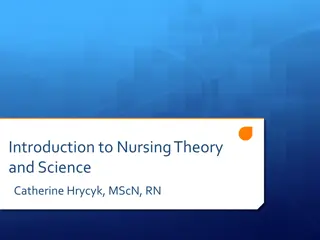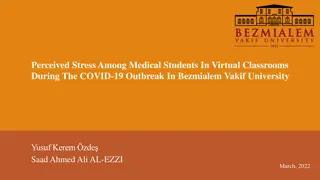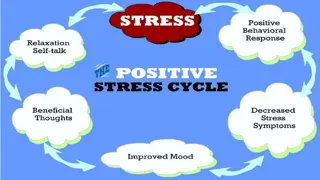Nursing Home Administrator Stress and Turnover Intent During COVID-19 Pandemic
Historically high turnover intent among Nursing Home Administrators (NHAs) has been associated with managerial ineffectiveness, staff morale issues, and poor patient care. This study aims to explore NHA turnover intent factors during the COVID-19 pandemic, including organizational constraints, pandemic stress, regulatory impacts, and staff-related challenges.
Download Presentation

Please find below an Image/Link to download the presentation.
The content on the website is provided AS IS for your information and personal use only. It may not be sold, licensed, or shared on other websites without obtaining consent from the author.If you encounter any issues during the download, it is possible that the publisher has removed the file from their server.
You are allowed to download the files provided on this website for personal or commercial use, subject to the condition that they are used lawfully. All files are the property of their respective owners.
The content on the website is provided AS IS for your information and personal use only. It may not be sold, licensed, or shared on other websites without obtaining consent from the author.
E N D
Presentation Transcript
Nursing home administrator (NHA) stress, dissatisfaction, and turnover intent during the COVID-19 pandemic H. WAYNE NELSON BO KYUM YANG MARY HELEN MCSWEENEY-FELD GERALD J. JEROME TETA BARRY (ARCADIA) JOYCE WEIL (QUALITATIVE) NATALIE THAYER (QUALITATIVE)
Funding The Foundation of the National Association of the Long-Term Care Administrator Boards (NAB): $10,221 College of Health Professions $5,000
Background: 1 Historically high NHA annual turnover Intent (TI), (24%) managerial instability which is associated with: suggests 2 NHA managerial ineffectiveness 3 Lower nursing and direct care staff morale 3 Higher staff turnover 4 More survey deficiencies 4,5,6 Poor patient care
Purpose Innovations: First national study to examine NHA TI that uses the following factors: Organizational Constraints COVID Pandemic Stress Regulatory Inspections Contract agency staff use Nursing Home regulatory complaints
Outcomes NHA TI quantitative article (Target: The Gerontologist) NHA Job Stressors and quit triggers qualitative article (Target The Gerontologist) ALF manager job stress and TI mixed-methods (TBD)
Theoretical Framework Roll Stress Theory 7 Met Expectations Theory of Job Satisfaction 6 Stress/dissatisfaction-coping-impulse-behavior syndrome 1
Study Design & Data Collection Sample, inclusion Criteria Licensed NHA employed willing to share NH name and address Qualtrics Survey (Sent between Feb 4 Though March 22) to all (n=22,779) NHAs in NAB data base Sixty-one Close-ended questions Three open ended questions 4,481 responses 1,139 Valid Reponses
Measures: Dependent Variable Turnover Intent (single question): Do you intend to leave the NH during the Next Year or So (1) I will definitely not leave to (5) I will definitely leave). 8 8
Independent (Psychological) Variables 9 COVID Stress: Ten (10) items, dealing (a) feeling able to control certain work circumstances (b) worry about difficulties that could emerge to influence their lives. Nursing Home Administrator Job Satisfaction Scale (NHA- JSQ) 10 Eighteen items (10-point scale range, from 1, very dissatisfied, to 10, very satisfied in 5 domians Work Content (residents, autonomy) Work Demand (supports etc.) Work-Load (schedule-manageable tasks) Skills (training and competence - role) Rewards (pay /advancement) Coworkers (relationships)
Independent (psychological) variables 12 Role Conflict and Role Ambiguity Fourteen item 7 point scale from 1 (Very false) to 7 (very true): RA I know exactly what is expected of me; RC: I receive incompatible requests from two or more people. 11 Organization Constraints Eleven item, 5-point scale, from 1, less than once pe month or never, to 5, several times a day, that how often constraints (bad boss, supplies, insufficient staff, bad information) impede work.
Study Variables (Structural/Organizational) (Select) Independent Variables Agency Contract staffing Facility Size # weeks staffing shortage Ownership (non-profit, Chain, etc.) High number of inspections High number of deficiencies NOTE: Regulatory findings from Certification and Survey Provider Enhanced Reporting System (CASPAR) data; facility characteristics from NH CMPARE (CMS)
Study Sample Race: White: 90.69% Other: 9.31% Gender Female: 58.15 Male: 41.85 Education Graduate or above 43.63 % Bachelors, 44.95 Less than Bachelors, 11.42% Age: M=50.87, SD= 11.21 Min=23, Max=83 Total Professional Tenure: 21.56 years, SD=11.39 Current Tenure: 7.1 years, SD=8 Facility Characteristics: 71.6% (50-150 beds), 58.65% working in chains 77.88% used agency contact staff
Statistical Analysis Generalized estimating equations were used to account for nursing homes clustered by state. Estimated adjusted odds ratios were used for turnover intent within a hierarchical approach. Model 1, examined the association of turnover intention with organizational characteristics Model 2, personal and psychological factors were added. In Model 3, COVID-stress was added to the analyses. We used R2 and AIC in examining the model NOTE All analyses were performed using SAS 9.4 and STATA MP version 13.
Significant Results Model 1 Organizational Characteristics AOR 95% CI Contract Staffing inspections 1.51 (1.11, 2.04) 1.11 (1.11, 2.01)
Significant Results Model 2 Organizational and Psychological factors AOR 95% CI High deficiencies Role Conflict Org. Constraints JS Skill JS Reward JS work Demand JS Workload 1.47 1.17 1.32 1.18 0.88 0.78 0.91 (1.06, 2.05) (1.04, 1.32) (1.05, 1.66) (1.05, 1.66) (0.82, 0.95) (0.69, 0.86) (0.85, 0.97)
Significant Results Model 3 Fully Adjusted AOR 95% CI Contact Staffing Role Conflict JS Skill JS Reward JS Work Demand JS Workload Pandemic Stress 1.50 1.17 1.18 0.87 0.78 0.91 1.65 (1.08, 2.09) (1.04, 1.32) (1.08, 1.30) (.081, 0.94) (0.70, 0.87) (0.86, 0.98) (1.22, 2.23)
Summary Key Findings The odds of NH administrator turnover intent is significantly higher for those experiencing higher Pandemic Stress compared to NHAs with lower Pandemic stress. The odds of NH administrator turnover intent is significantly higher in those with high agency staff use than those with low or no agency staff use. JS continues to be a good predictor of TI with NHAs more satisfied with workload, work demands, and rewards contributed to lower turnover intent. Counterintuitively, Skill satisfied NHAS, were more likely to express turnover intent. TI was moderately higher in this COVID study (31.54) than our 2021 study (24)% RC persists as a good predictor of TI as in our pre-covid study
Summary Key Findings (Cont.) Forty six percent of NHAs did not express TI NHAs were most satisfied with work content, (M = 8.80/10) higher than than in our pre-COVID study and other JSQ studies (higher rescue hopes?) JS workload was lower (M = 5.25) in th is COVID study than in previous JHSQ research (6.25).
References 1. Nelson, H.W., Yang, B.K, Carter, M.W., Monahan, E., & Engineer, C. (2021). Nursing home administrators job satisfaction, work stressors, and intent to leave the profession. Journal of Applied Gerontology, 40(1), 67 76. https://doi.org/10.1177/0733464819896572 2. Mobley, W.H. (1982) Employee Turnover: Causes, Consequences, and Control. Boston, MA: Addison-Wesley. 3. Castle, N. G. (2005). Turnover begets turnover. Gerontologist, 45(2), 186-195. https://doi.org/10.1093/geront/45.2.186 4. Castle, N. G. (2001). Administrator turnover and quality of care in nursing homes. The Gerontologist, 41(6), 757 767. https://doi.org/10.1093/geront/41.6.757 5. Angelelli, J. Gifford, D., Shah, A., & Mor, V. (2001). External threats and nursing home administrator turnover. Health Care Management Review, 26(3), 52-62. https://doi.org/10.1097/00004010-20010700- 00006 6. Falatah R. (2021). The impact of the coronavirus disease (COVID-19) pandemic on nurses turnover intention: An integrative review. Nursing Reports, 11(4), 787 810. https://doi.org/10.3390/nursrep11040075 7. Bakker, A.B. & Demerouti, E. (2007). The job demands-resources model: State of the art. Journal of Managerial Psychology, 22(3), 309-328. https://doi.org/10.1108/026839407107333115 8. Francis-Felson, L.C., Coward, R.THorne, C. (1996) Factors influencing intentions of nursing personnel to leave employment in long-term care settings. Journal of Applied Gerontology 15(4) https://doi.org/10.1177/073346489601500404 9.Campo-Arias, A., Pedrozo-Cort s, M. J., & Pedrozo-Pupo, J. C. (2020). Escala de estr s percibido relacionado con la pandemia de COVID-19: una exploraci n del desempe o psicom trico en l nea. (Spanish). Revista Colombiana de Psiquiatria, 49(4), 229 230. https://doi.org/10.1016/j.rcp.2021.06.004 10Castle, N. G. (2006a). An instrument to measure job satisfaction of nursing home administrators. BMC Medical Research Methodology, 6, 47, https://doi.org/10.1186/1471-2288-6-47. 11. Spector, P.E., Jex, S.M. (1998) Development of four self-report measures of job stressors and strain: Interpersonal Conflict at Work Scale, Organizational Constraints Scale, Quantitative Workload Inventory, and Physical Symptoms Inventory. Journal of Occupational Health Psychology, 3(4), 356 367. https://doi.org/10.1037/1076-8998.3.4.356 12Rizzo, J. R., House, R. J., & Lirtzman, S. (1970). Role conflict and role ambiguity in complex organizations. Administrative Science Quarterly, 15(2), 150-163. http://dx.doi.org/10.2307/2391486
